DUTERTE’S SHOPAHOLIC ARMED FORCES STRIKES AGAIN: How ‘Kill Kill Kill’ misuses people’s funds then harms them
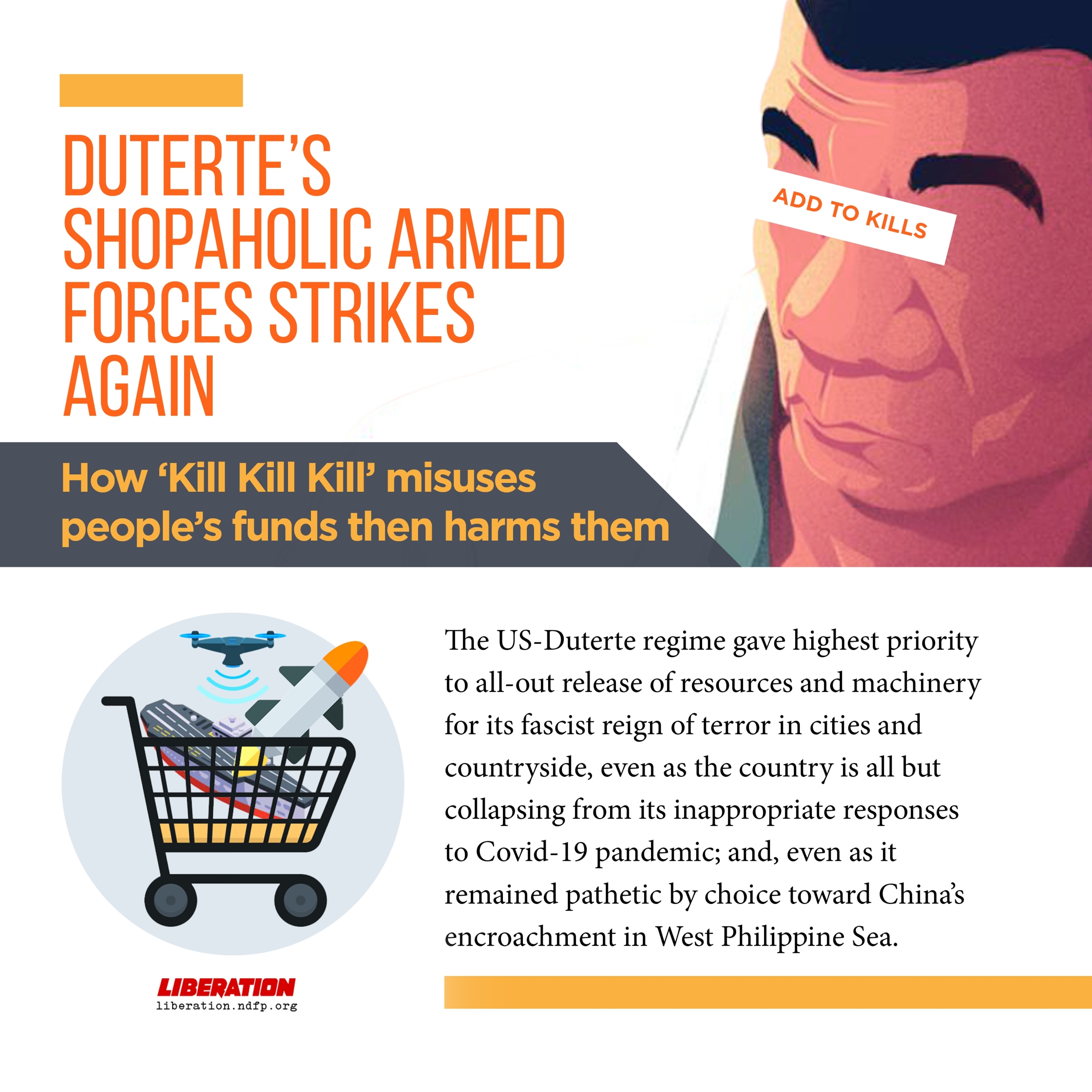


In a recent collated report, the Philippine Revolution Web Central traced a disturbing modus operandi of the Armed Forces of

“This is the Chinese Coast guard. This is under the jurisdiction of the Chinese government,” blared a Chinese officer who

by Pinky Ang The on again off again peace negotiations—scuttled by the Duterte regime—can still be saved if the people

“This is the Chinese Coast guard. This is under the jurisdiction of the Chinese government,” blared a Chinese officer who tried to bar a cargo ship from sailing through Panatag/Scarborough Shoal, a part of the Philippine territory off Zambales province in the South China Sea. His action has sparked an outcry, but as of this writing, the Duterte administration continues to avoid offending China.
Its officials—from Malacañang to the Foreign Secretary to the Philippine Coast Guard— have all refused to call out China’s infraction on Philippine sovereignty and on freedom of navigation. Meanwhile, at a Senate hearing around the same period, Defense Secretary Delfin Lorenzana stirred patriotic outrage when he downplayed the Chinese ships’ firing of flares as Philippine ships navigated the West Philippine Sea.
These are just two incidents in a series of cases of Chinese incursions into Philippine territory, all unchallenged, being dismissed, and at times even justified by the Duterte regime. Why would a tough-talking and cursing president, who advertises his stance as “charting an independent foreign policy,” court the people’s ire with blatant subservience? Perhaps, this question should begin with “How much…?”
The first time President Rodrigo Duterte visited China three years ago, the Communist Party of the Philippines (CPP) already enumerated ways in which the Filipino people may benefit from ties with China. This would start ONLY IF Duterte strives to build diplomatic relations with China on the basis of equality, mutual respect, and mutual benefits, the CPP said at the time.
But Duterte did not listen. Instead he has shown that he is not at all capable of building diplomatic relations with China on the basis of equality, mutual respect, and mutual benefits. He has persistently desisted from asserting the country’s victory at the Permanent Court of Arbitration in The Hague, claiming China would wage war against the Philippines if he did so (which has no basis in fact). Thus, he has let pass China’s repeated incursions into our country’s extended economic zones (under the United Nations’ Convention on the Law of the Sea or UNCLOS) and bully Filipino fishers at Panatag Shoal.
Probably believing that in the prevailing system, presidents like him couldn’t be anything other than the worst imperialist puppets and bureaucrat capitalists of the day, Duterte is angling for whatever gains he could get from deals with the imperialists. His administration calls China an “integral partner” in their P4.23-trillion infrastructure buildup.
By now it is clear the only change that has come with Duterte is that besides serving US imperialist interests (while feigning to be distancing from it), his administration is moonlighting with another imperialist power, letting it latch on to wherever it can partake of the country’s riches and potentials.
The country’s foremost bureaucrat capitalist finds in China a promising huge pot of bureaucratic loot as former sources have dried up due to the economic slowdown, or are compelled by their citizens to raise questions on and denounce continuing extrajudicial killings and other human rights violations under his increasingly tyrannical rule. On this issue the Duterte administration is allergic to what he deems as foreign intervention.
“Duterte is in a hurry and desperate to secure his kickbacks from foreign loans and contracts from China,” the CPP said in a statement when Duterte still had three years in power. Duterte’s list of projects, flagship or otherwise, has since continued to evolve or get revised.
After three years in power, only nine of Duterte’s 75 listed “Build, Build, Build” projects begun construction. By November 2019, Duterte dropped the projects considered too long or unfeasible. It ‘overhauled’ the list such that only 30-plus of the original projects remained, and added another 68 to the “evolving” list. Half or 50 of Duterte’s flagship infrastructure projects will be funded by Overseas Development Assistance (ODA) or foreign loans, 23 are to be fully funded by the Philippine government, 24 by public-private funding, and only two will be privately financed.
Duterte’s panic over delayed delivery of the loot is palpable. Past midway in his six-year term, the amount supplied so far by China in loans and grants is still far short of the US$9 billion promised by President Xi Jinping during their first meeting in October 2016. Having already signed numerous deals with the Chinese government, his administration wants to proceed with implementing the projects ASAP so the funds could start pouring in. That can happen, of course, only if his administration can overcome the public criticisms and protests over the lopsided provisions of the deals that have been made public, criticisms for the lack of transparency on deals that have yet to be disclosed, and delays in completing the technical and legal requirements that include feasibility studies, environmental clearances, and the freely given consent of communities that would be adversely affected.
A sample of what the Duterte administration can do to push its deals with China: in time for the visit of Chinese vice-premier Hu Chunhua in October 2019, it railroaded the release of environmental compliance certificate and threatened to use police power against public protests on the Kaliwa Dam project in Sierra Madre. Yet, the protests were such that as of February 2020, his economic manager confirmed they have barely started construction in Kaliwa.
Protests against the China-funded projects hinder its implementation. Past debacles with China-funded projects such as the ZTE and Northrail also cast its shadow, slowing down Duterte’s hope for inflows of ODA from China. Until December 2019, the Chinese government wanted meetings with the Duterte government “to thresh out issues involving the Duterte regime’s big-ticket infrastructure and development projects that are being implemented with funding support from China.”
To push through with the projects Duterte needs to remove all constraints including protests. His government has busied itself imposing a de facto martial law since establishing the National Task Force to End Local Armed Conflict (NTF-ELCAC) in December 2018, ordering to place civilian bureaucracies and local governments under the task force.
But Duterte cannot trample on the people’s rights and welfare on the way to collecting his loot and still maintain his dubious popularity. To deceive supporters, he is passing off his “China pivot” as “independent foreign policy.” He is also using it as leverage for demanding more support and funds from the Philippines’ long-time neocolonial master, without really upsetting the established “special relationship” with US imperialist overlords.
In fact, as a US puppet, Duterte is providing exemplary services to his master. He sets the stage for the Pentagon and the Department of National Defense-Armed Forces of the Philippines to use the China card to both increase and extend US military presence in the country. The US has been allowed to have another military facility, this time within a Philippine Air Force base in Palawan. Under Duterte, the US military and the AFP have also conducted an increasing number of war exercises designed to counter China’s military build-up in the South China Sea.
“The aim of these exercises is to ensure that the US will remain militarily dominant in order to protect its economic interests in the Philippines and across the region,” the CPP said in a statement during the Kamandag US military exercises in October 2019.
As president and “public servant,” Duterte continues to expose himself as a total scam. And so, to block protests and increasing calls for his ouster while he strives to make his puppetry to US and China more profitable for himself and his clique, he continues to militarize the bureaucracy and the entire government.
In 2019 his government allowed a military rampage nationwide on the basis of their ‘whole of nation approach’, a harsh and more insidious martial law than that carried out for 14 years by the ousted fascist dictator Ferdinand Marcos (whom he has politically rehabilitated by allowing his preserved corpse buried at the Libingan ng mga Bayani in 2017).
The Duterte regime has looked the other way as China finished reclaiming and installing military installations over three reefs within Philippine territorial waters. Duterte has all but given the green light to China’s staking claim and proceeding with plans to construct more installations at the Panatag Shoal. He is all but allowing also what amounts to China’s military encirclement of the seas around Luzon, sans any written treaty.
Commercially, China is also gaining humongous ground with the lopsided “joint” deal it signed with Duterte to explore and drill for oil in the resource-rich West Philippine Sea. Officials from the Duterte regime and China are meeting regarding the “joint” oil exploration.
The increased Chinese presence in Philippine coastal areas, islands and waters has placed fisherfolk and urban communities at a grave disadvantage. China’s aggressive grab of Filipinos’ traditional commercial fishing grounds has worsened the fisherfolk’s lot.
Not just in Philippine reefs and seas, China is also boldly entering vital Philippine industries and staking claim over rich natural resources in ancestral territories of indigenous peoples through opaque or lopsided deals with Duterte. As earlier stated, China’s actual fund release in Duterte’s big-ticket “Build, Build, Build” infrastructure projects is so far negligible. But the projects where it is bound to come in, per the deals already signed, and where other private and state-controlled Chinese firms are coming in are many times bigger and more dangerous than the NBN-ZTE deal for which Gloria Macapagal-Arroyo got burned late in her disputably prolonged nine-year term.
Some of the strategic industries where China loans or investments have come in or are in the pipeline include energy (China already owns as much as 40% stake in the National Grid of the Philippines), telecommunications (Dennis Uy’s Mislatel/Dito Telecommunity), water, heavy railways, and various infrastructure projects such as bridges and highways, real estate development including economic zones and islands to be devoted more or less exclusively for Chinese business and gambling operations.
These businesses being opened to China may be par for the course for any imperialist puppet, but Duterte is adding more, “industries” and “trading” such as gambling and drugs. Given Duterte’s red carpet for China, the Philippines has been putting up dens for gambling operations for mostly Chinese operators. Duterte, who has been publicly known as friendly to Chinese drug lords, has also repeatedly been implicated in the illegal drugs trade. The CPP describes him as the overlord of illegal drugs trade in the country.
For now, Duterte has already shown how he has been selling out the country and committing high treason. While Duterte is not the first Philippine puppet president to have entered into lopsided deals with China, his regime surely leads in ramping it up. ###
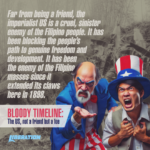
US leaders from its president to lawmakers and military chiefs call the Philippines its oldest, longest treaty partner in Asia.

Before they underwent massive PR makeovers in Hollywood movies, the vampires are some of the best graphic tools used to

Pahayag ng mga kasaping organisasyon ng National Democratic Front of the Philippines (NDFP) sa okasyon ng ika-51 Anibersaryo ng pagkakatatag

The on again off again peace negotiations—scuttled by the Duterte regime—can still be saved if the people correct and debunk all the misinformation being lobbed against it by the militarists, the peace spoilers, and hawkish officials of the Duterte regime.
The following so far are some of the plain truth and observable reality on the ground which peace spoilers try so hard to deny or, failing there, to vilify and demonize. Feel free to add.
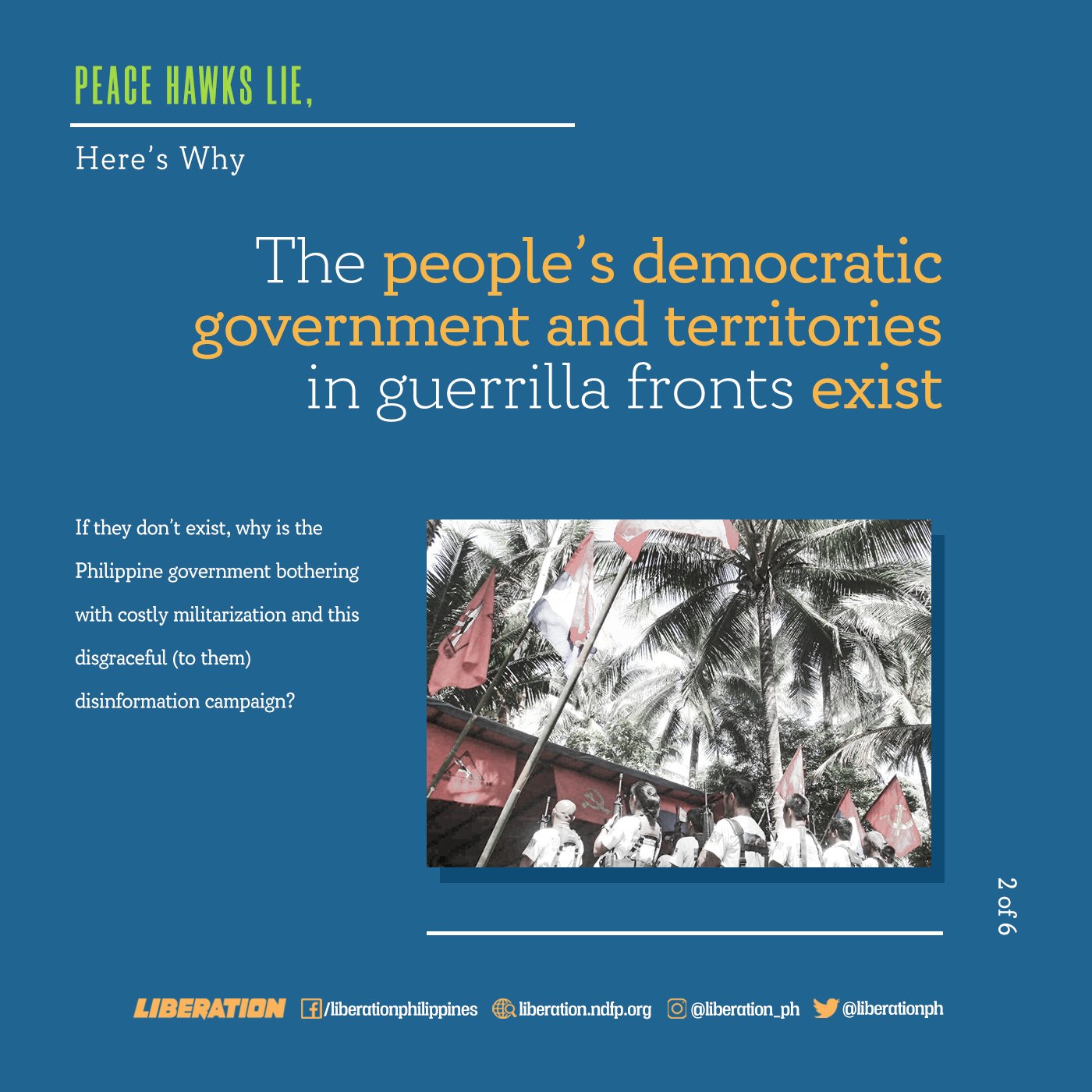
The guerrilla fronts have expanded to about a hundred amid the continuing intensified militarization topped by increased use of civilian bureaucracy for waging war against the people. The simplest response to government or militarist denial of the existence of the people’s democratic government is: if they don’t exist, why is the Philippine government bothering with costly militarization and this disgraceful (to them) disinformation campaign?
The people’s democratic government continues to advance land reform, revolutionary justice, defense of human and natural resources for national industrialization. The government of the Republic of the Philippines and its mercenary troops know and confirm this every time they present their faked or forced surrenderers (mostly civilian farmers or government soldier pretending to be a rebel); when they order local government to declare the Communist Party and the New People’s Army as persona non grata; or when they rail against revolutionary taxation or village militias flexing muscles to defend themselves.
The Duterte regime and the militarists precisely know the existence of guerrilla fronts and people’s democratic government as they vainly try to trap them in localized peace talks. They have long failed to appreciate that the rebels aren’t as corruptible as the AFP or PNP generals. Or that the revolutionary movement continues to expand despite or because of sufferings the military and the plunderers inflict on the people.
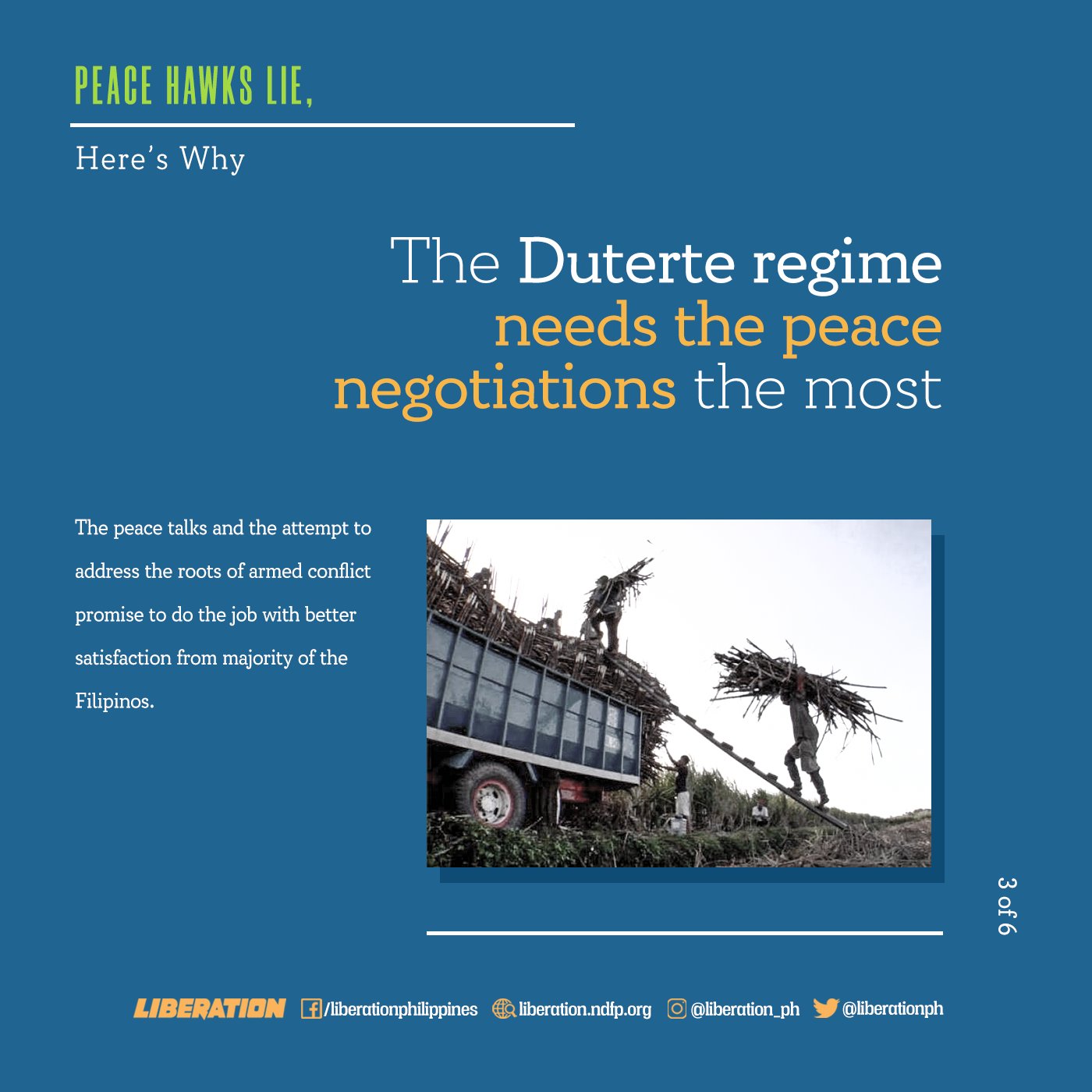
The Duterte regime is now weighed down by the sheer amount of blood shed because of his dirty wars against the poor. Meanwhile, no amount of magic in official statistics can hide that the economy is not as good as it projects, and that the majority of the Filipinos are worse off.
Now in his lameduck years in Malacañang, Duterte can’t fail to notice that even his highest military subordinates (Hermogenes Esperon, Jr., Delfin Lorenzana, Eduardo Año, Carlito Galvez, and Filemon Santos, Jr.) have so publicly opposed his intent to resume peace negotiations between the GRP and the NDFP. Instead of addressing the roots of the armed conflict to ready the ground for peace, these military subordinates want to continue their military rampage, as well as the drive to place the government and society under military rule through Executive Order No. 70.
Unfortunately for Duterte, he is the commander-in-chief to be tried for his accountability to war crimes, and his regime is what’s on the line for history’s reckoning. His military subordinates, meanwhile, have rampaged and butchered up till their retirement from the AFP. Yet they still failed to bring down the revolutionaries through the years, through failed deadlines, under different presidents.
It doesn’t need rocket science to grasp that the Philippine government cannot win the war by military solution alone. The peace talks and the attempt to address the roots of armed conflict promise to do the job with better satisfaction from majority of the Filipinos.
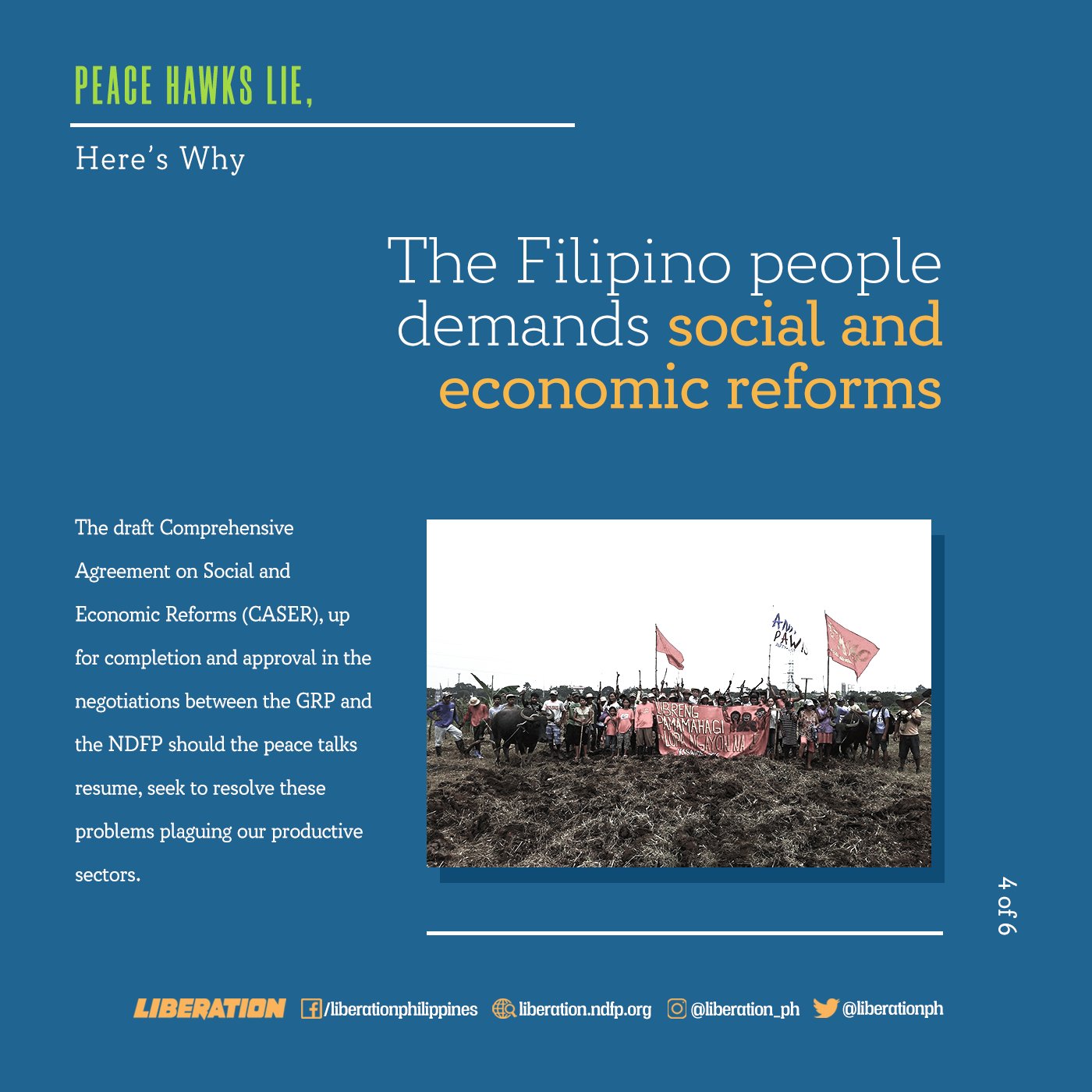
The way Duterte’s recycled generals and hawkish officials speak, you’d think the Filipinos live already in an industrial paradise, without social injustices, without worsening unemployment, low incomes and rampant poverty. Of course these exist only in their brags and baseless beliefs. The Philippine economy stands only propped up by a bloated unproductive services sector, overseas remittances, and debt. It begs for scraps from foreign investments who take away more from the country than what they bring in.
The country’s agriculture and industry have steadily declined no thanks to the past and present government’s neoliberal policies. The draft Comprehensive Agreement on Social and Economic Reforms (CASER), up for completion and approval in the negotiations between the GRP and the NDFP should the peace talks resume, seek to resolve these problems plaguing our productive sectors.
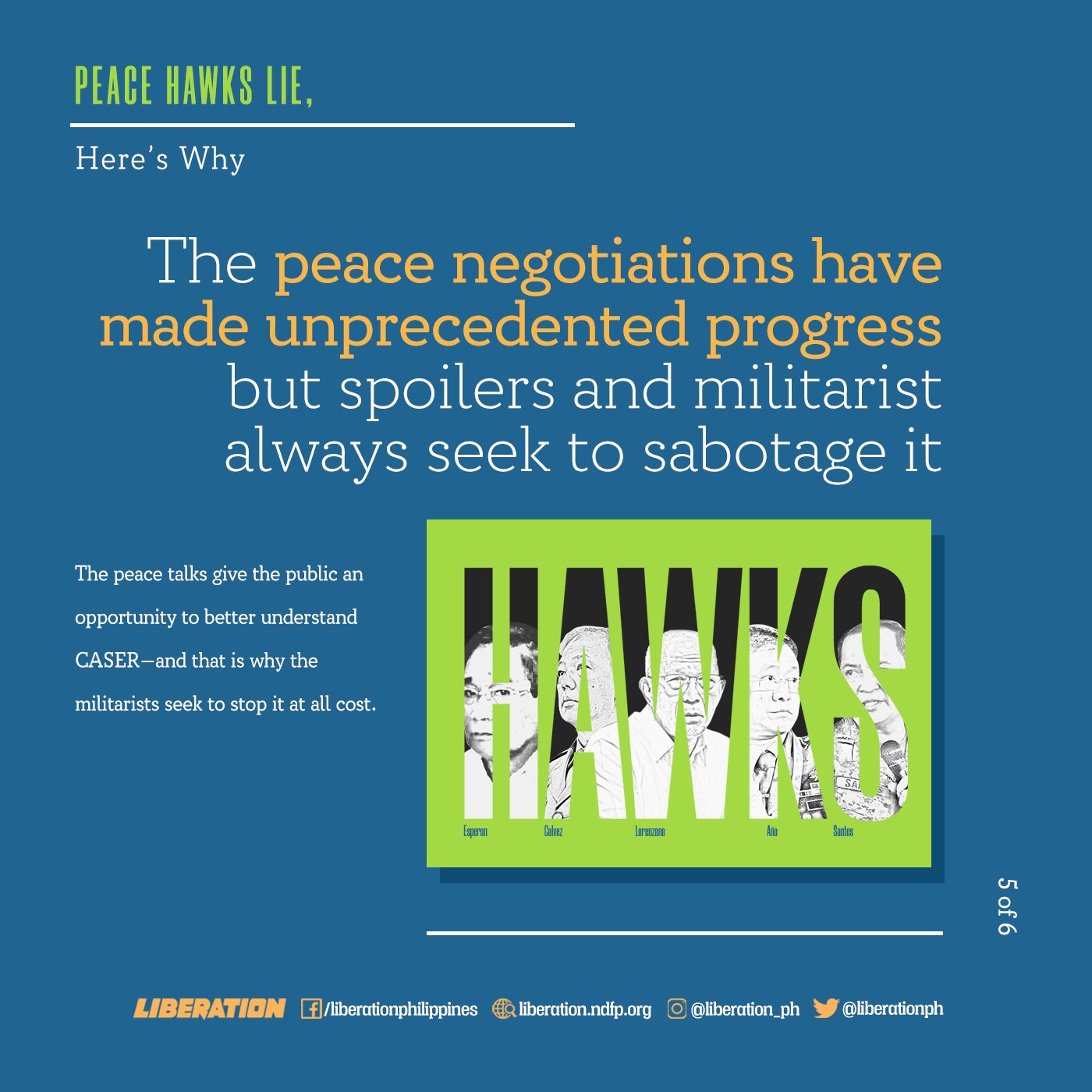
The peace talks that started in 2016 have progressed in fleshing out the CASER, the meat of the peace negotiations. It used to exist as two different drafts of the negotiating panels. Before talks were halted in 2018, the four formal rounds of peace talks abroad and seven meetings in the Philippines had produced a common outline and substantial drafts on two of the most important sections of CASER: Agrarian Reform and Rural Development (ARRD) and National Industrialization and Economic Development (NIED). These two alone can give vast benefits for tens of millions of Filipinos and the cause of national development.
The peace talks give the public an opportunity to better understand CASER—and that is why the militarists seek to stop it at all cost. They will be thoroughly exposed not only as peace saboteurs but as agents of enemies of the Filipino people.
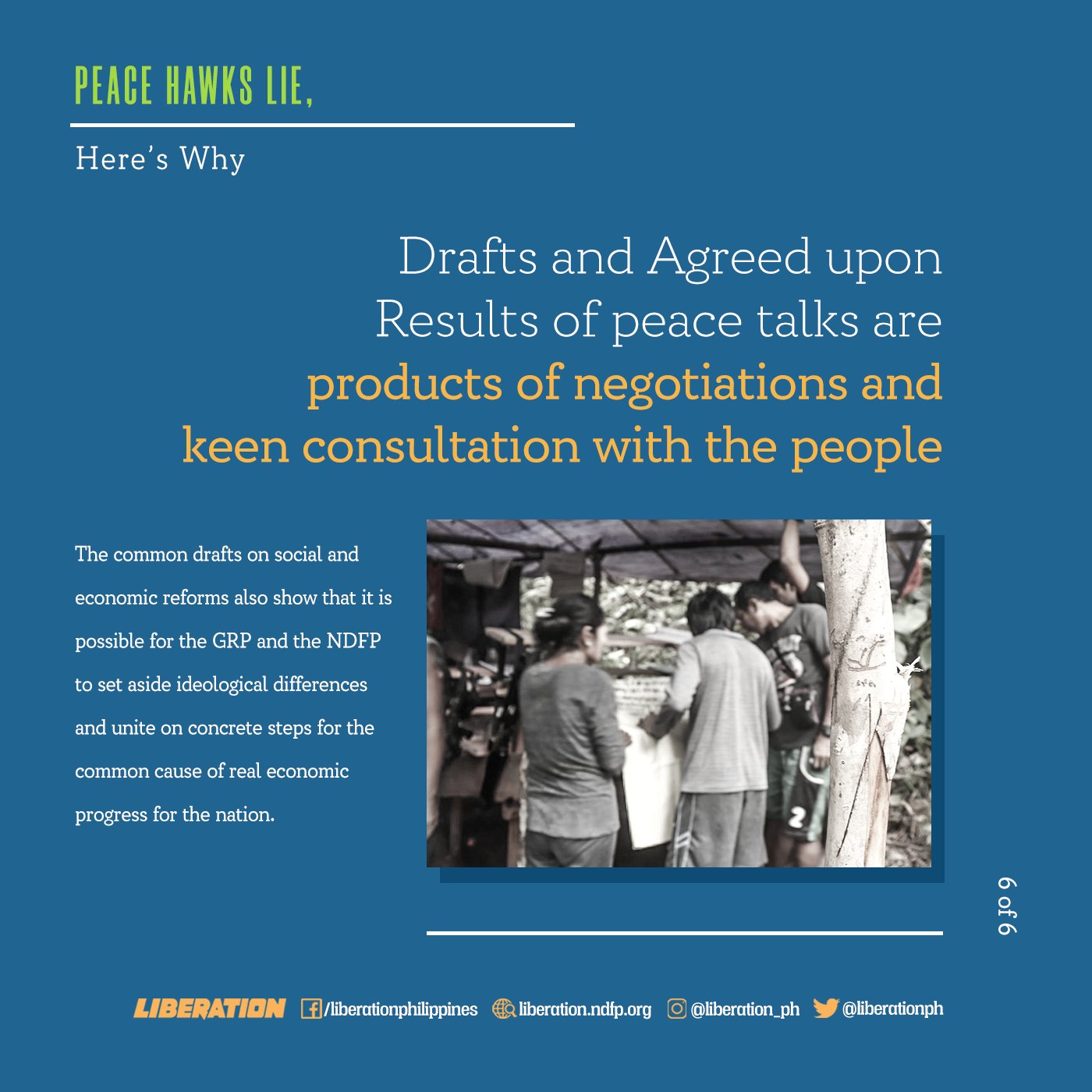
Whatever common drafts have been mutually agreed upon and prepared by the negotiating parties and their working groups, these were discussed and to be approved by the NDFP and GRP negotiating panels. These are no secret nor unilateral impositions—things the militarists have been known of hatching up. With regard to the NDFP proposals, these are reflection not only of the people’s desire but of the developments in the guerrilla zones. The drafts were widely disseminated and still being disseminated and discussed in guerrilla zones; and also being updated as the years go by.
The common drafts on social and economic reforms also show that it is possible for the GRP and the NDFP to set aside ideological differences and unite on concrete steps for the common cause of real economic progress for the nation.
With the people’s resolve to push for just and lasting peace, the militarists and peace spoilers, who have failed so spectacularly at bringing about peace, will not succeed at sabotaging again the peace negotiations. ###
#ResumeTalks
#SignCASER
#JustPeace
—–
VISIT and FOLLOW
Website: https://liberation.ndfp.info
Facebook: https://fb.com/liberationphilippines
Twitter: https://twitter.com/liberationph
Instagram: https://instagram.com/liberation_ph
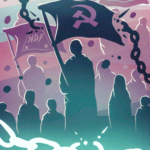
The CPP-NPA-NDFP is not one and the same organization. These are three distinct organizations, even as they have the same

Below is a sampler list indicative of what (or how much) the US-Duterte regime has so far achieved as an
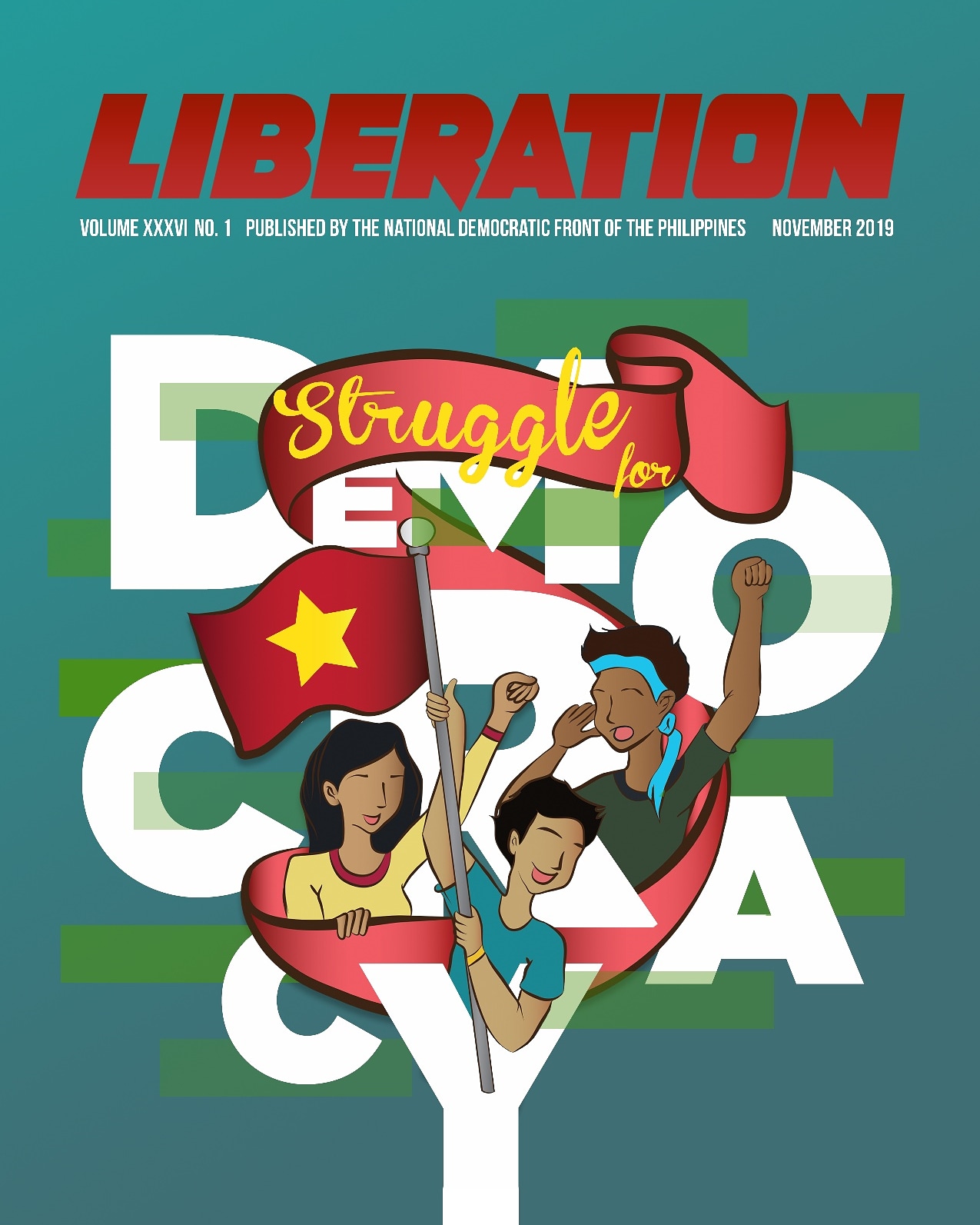
Since 1981, when the Marcos dictatorship initiated Operational Plan (Oplan) Katatagan purportedly “to defend the state” (the besieged fascist regime) from the fast-growing New People’s Army (NPA), each succeeding administration has followed suit. This is understandable, since the planner-implementor of every Oplan has been the same military establishment habituated to martial-rule repressive action.The Oplans have had varying names. Yet all have been aimed at deterring the growth of or strategically defeating the NPA, to preserve the existing rotten ruling system.These were: Corazon C. Aquino’s Oplan Mamamayan and Oplan Lambat-Bitag I and II; Fidel Ramos’ Lambat-Bitag III and IV, and Oplans Makabayan and Balangay (which transitted into Joseph Estrada’s truncated presidency); Gloria Arroyo’s Oplan Bantay Laya I and II; Benigno Aquino III’s Oplan Bayanihan; and Rodrigo Duterte’s Oplan Kapayapaan and Oplan Kapanatagan.While each succeeding administration adopted its predecessor’s operational concepts, it added new ones. But all such operational concepts were, invariably, copied from the counterinsurgency guide of the US Army. Although these may have worked for some time in America’s wars of aggression and intervention in different parts of the world, over the long run they have failed to achieve their prime objective: decisive military victory.Instead, these American wars—practically wars against the peoples of the countries they invaded, starting with the Philippines at the turn of the 20th century—have left behind countless deaths mostly of civilians, including children; pervasive human rights violations; displacements en masse of the population; and massive destruction of socio-economic resources requiring decades to recover.Similarly, albeit in smaller scale, these have been the dire impacts of the successive counterinsurgency Oplans on our people—since Marcos’ time to the present—in the undefined arenas of war across the archipelago, mostly in the countrysides and hinterlands.The current Oplan Kapanatagan started as Oplan Kapayapaan in January 2017. The latter was also dubbed as the AFP Development Support and Security Plan 2017-2022, which the Armed Forces off the Philippines (AFP) described as an advance from Aquino III’s Oplan Bayanihan. It adopted the latter’s “whole-of-nation” or “people-centered” approach. Oplan Bayanihan, the AFP bragged, resulted in getting 71 of the 76 (out of 86) provinces deemed to be “insurgency affected” declared as “insurgency free” and “peaceful and ready for further development.”The change to Kapanatagan stemmed from the AFP’s assessment that Oplan Kapayapaan was failing to achieve its targeted goal to defeat the NPA midway of Duterte’s six-year term of office.When first announced by AFP chief Gen. Benjamin Madrigal before the May 2019 midterm elections, it was billed as the AFP-PNP Joint Campaign Plan “Kapanatagan” 2018-2022. Madrigal described it as a “medium-term broad plan that shall guide the AFP and Philippine National Police (PNP) in providing guidelines and delineation of authority while performing their mandated tasks to promote peace, ensure security, and support the overall development initiatives of the government towards inclusive growth.” It is anchored, he added, on the national strategic guidance defined in the National Vision, National Security Policy, Philippine Development Plan, National Peace and Development Agenda, and the 2018 Department of National Defence (DND) Guidance and Policy Thrusts.“The respective strategic thrusts of the AFP and PNP were thus harmonized in this Joint Campaign Plan “Kapanatagan” 2018-2022,” Madrigal said. He called it “a dynamic process to establish greater inter-operability in our continuing operations to address security concerns within our respective areas of concern, including all other productive endeavors wherein we join hands in support of national government initiatives as envisioned by President Rodrigo R. Duterte.”Specifically, Madrigal cited two “salient features” of Campaign Plan Kapanatagan: 1) The PNP shall support the AFP in combat operations involving the suppression of insurgency and other serious threats to national security; and 2) The PNP shall take the lead role in law-enforcement operations against criminal syndicates and private armed groups, with the active support of the AFP.”It was in the Cordillera region where the AFP and PNP first “rolled out” Oplan Kapanatagan, after the May midterm elections. Northern Luzon Command (Nolcom) chief Lt. Gen. Emmanuel Salamat then said: “Because of the effort of the AFP and PNP in preventing violence and any actions of the local terrorist groups in the Cordillera region, we assure that the AFP and PNP will continue to work together through Joint Kapanatagan Cordillera.”He emphasized that the AFP-PNP would carry out “joint actions and plans to ensure a more collaborative effort to address the peace and security concerns, especially in those geographic isolated areas” (the guerrilla zones) in Cordillera. He expressed hope that the local government units and other “partner agencies” would collaborate to ensure implementation of Executive Order 70 and the National Task Force to End the Local Communist Armed Conflict (NTF-ELCAC) it created, headed by Duterte.Gen. Salamat disclosed that at a “national convergence” meeting in Malacañang, all those working under NTF-ELCAC had put all efforts “to come up with a cluster of responses” on the different issues, including “issues that have been exploited by the local terrorist groups” so that the government can respond to them.And how has the government responded through NTF-ELCAC and Oplan Kapanatagan?Recently, the Cordillera People’s Democratic Front (CPDF-National Democratic Front of the Philippines) issued a primer on this two-in-one counterinsurgency plan, titled “Disturbance and Plunder by the State Against the People.” Among others, it points out the following:R(egional)TF-ELCAC Cordillera was formed in July 2019, followed by P(rovincial)TF-ELCAC Mt. Province in September. In the last three months of the year municipal-and barangay-level TFs are targeted to be formed.In September, Nolcom launched military operations in various parts of the Cordillera and Ilocos regions, side-by-side with these joint campaigns by the AFP and PNP: disinfomation, surveillance, psychological war (disseminating false information that the NPA had planted land mines in the mountain areas of Bauko, Tadian, and Sagada towns in Mt. Province); forcible entry into civilian homes purportedly to “collect” firearms kept for the NPA in the communities of Besao town; threat and pressure used on residents summoned to pulong masa to sign up on a memorandum of agreement with the AFP-PNP and a declaration of the CPP-NPA as “persona non grata”; holding seminars and symposia on Duterte’s “war on drugs”; and delivery of “services”, “relief and rehabilitation”, among others.The AFP-PNP also set up detachments within three communities of Besao and one in Sagada, in violation of the Comprehensive Agreement on the Respect for Human Rights and International Humanitarian Law (CARHRIHL). (In the National Capital Region, through Implan/Oplan Kalasag, the NCR version of Oplan Katatagan, the AFP-PNP tandem has also set up detachments in some communities in Caloocan City. Uniformed armed teams engage in red-tagging, harassment, intimidation, while others offer “livelihood programs” to identified leaders and members of progressive organizations).CPDF also says the implementation of Oplan Katatagan and NTF-ELCAC in the region aims to facilitate the entry of energy and mining projects by foreign-local joint ventures that threaten the ecology, and violate the Cordillera people’s right to their ancestral lands. It named the following: Bimaka Renewable Energy Devt. Corp., Hydroelectric Dev’t Corp., Chico River Pump Irrigation Project by China’s CAMC Engineering, Aragorn Power Energy Corp., and Cordillera Exploration Co. Inc.-Nickel Asia of Japan.In sum, CPDF denounces the two-in-one campaign as designed to “pacify and press the people to obey the dictates of the reactionary state.” It calls on the Cordillera people to assert their rights, oppose the campaign through various means, and expose the true intent of the campaign: to crush the just struggle of the oppressed masses.It’s useful to note that, in 1981 the Marcos dictatorship already employed thru Oplan Katatagan the full force of the AFP, the police and paramilitary forces, its “development agencies”, and some civilian organizations. Duterte’s Oplan Kapanatagan and NTF-ELCAC—backed up by extended martial law in Mindanao and state of national emergency in other areas of the country—can be correctly described as an “Enhanced Oplan Katatagan.” Note further: the Oplan failed—in 1986 the people ousted Marcos.#FightTyranny
#StruggleForDemocracyDOWNLOAD LIBERATION NOVEMBER 2019 ISSUE:
https://drive.google.com/folderview?id=1-gzWR8-ZOqiK8RlJa0qS1klqWkgIEKUZ—–
VISIT and FOLLOW
Website: https://liberation.ndfp.info
Facebook: https://fb.com/liberationphilippines
Twitter: https://twitter.com/liberationph
Instagram: https://instagram.com/liberation_ph
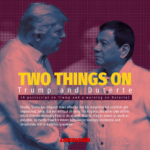
Finally, Trump has stepped down after he lost his reelection bid and then got impeached, twice. But not without showing

Here is an initial list of ex-military and police officials in the civilian bureaucracy—from the Cabinet to the major attached
